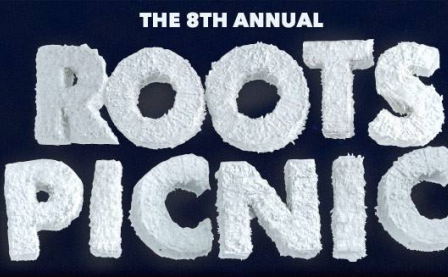It’d be unfair to call undun ‘hip-hop’ and nothing other. The Roots are, of course, both boom-bappers in every immediate sense of the word and their storied tradition: black, urban Americans kick-snaring urban ghetto narratives that rhyme. Hip-hop always has and still seems their creative impetus — say, a young something-teen-year-old ?uesto’s knuckles banging on a hollow and anything-but-acoustic art school lunch table with friend Tariq’s freestyling emotions, drawing a crowd — the nihilists, slidy-eyed thugs, and even goths otherwise unseen behind black bangs and nails stroking their still-wet still-life portraits — all nodding. All nodding with a knuckle cadence of which they never knew to be so emotional and full, with hip-hop at its barest born of objects and places and people otherwise forgotten to rot in Americana’s garbage-strewn back alley.
But where so many of their contemporaries run through the alley, heeding nothing — certainly not the wide-eyed child with face pressed impressionable against a fence — that means nothing from where they’re so surely meant to sit behind tint and in comfort; “The OtherSide,” as those say with a twinkle gleamed off chrome rims in their eye. The Roots walk slowly, smelling the weeds and overgrowth in the sidewalk cracks. They walk for walking’s sake.
It’d be unfair to call undun only hip-hop, because what’s hip-hop today is often two-dimensional and flat. And with the internet, it’s too easy for any hustler with half a brain, catchy hook, and get-rich will to do just that. Too easy because the audience, nowadays, wants it so — smiling; that the TV’s never off is all they see, it and its ads like somebody smiling warmly for them to smile back; selecting and readying the evening’s entertainment discs, those most smile-inducing and -keeping, for remote insertion into the viewer’s drive; reclining before the screen, with their TV dinners microwave-steaming pleasantly on their chairs’ infomercial-order attachable trays molded over their heads so that they may enjoy it without taking their eyes from the screen. Like everything else they consume, modern Americans want their art, and so their hip-hop, easy and fast.
undun can’t undo such blind voracity, but the album is a much-needed antithesis, if only for 40 short minutes. It’s difficult; the narrative is very post-postmodern-inverted, beginning with protagonist Stephen Redford’s death, then tracing aback. That Redford is a fictionalized composite of a few emcees (and presumably each own’s unique urban ghetto experiences), conveyed matter-of-factly and with hardly a specific character or scene detail, only highlights the misdirection and his world’s tragic ambivalence towards him. So the listener need be an equally astute one. The text, as The Roots seem to so badly want their lyrics and score read, inscribes a parabolic curve of sorts. Any object in parabolic orbit moves at the exact escape velocity of the object it’s orbiting, as Redford is born of and lives by his environment’s will. For him, when he himself thinks about it, inexplicably so. The curve orients itself symmetrically about a vertex, a crucial point, which is here the murder implied midway through “Stomp.” It’s a crucial point, though not necessarily the climax: like a parabola or satellite dish that doesn’t distort those waves of information but rather focuses and reflects them spatially in front of itself, Redford’s fate is inevitably futile and set before him by environs that both birthed and will kill him — not only from the opening “Dun” and his physical death, but also from the end, “Redford” and the three Movements (“Possibility,” “Will to Power,” and “Finality”), his metaphorical already-deadness at waking. A staging where both Redford himself, rendered a self-conscious urban-everyman through a calculated lack of character specifics and development, and his death is not nearly as tragic as the environs having him “staring at a future,” a gun and its hair-trigger, “in the creases of my hand” in the first place.
As such, it seems undun might be better self-served with more concrete scene-setting of, say, the building or project apartment or whatever hole-in-the-wall in which he might be waking up in “Redford” or in “Stomp,” maybe the passersby he’s too headlong gassing his to-be drive-by-shooting vehicle to notice. “The OtherSide” is the exception, where Thought-as-Redford raps, “Yeah outside where the killers and the dealers swarm/ And inside they dressed up like it’s a telethon/ Black tie affair but they holding heavy arms/ Straight cash with a stash in the cummerbund,” which concisely portraits a high-rolling party roiling with folks who make less-than-legal livings, types living fast and dangerously. Elsewhere on the record, Redford seems almost too reflexive and self-aware to be believed to be so helpless. The listener needs something or, especially for urban-everyman Redford, somewhere, to root against to really feel for him. However, the myriad emcee voices, per se, could as easily be heard as providing all the detail The Roots and their Redford’s conscious really need: that every voice, with each its own tone and mood and rhyme scheme, conveys different interpretations of the events and ideas leading to his death, much like an unhealthy brain playing against itself, as an unhealthy environment does its stuck dweller.
More about: The Roots




